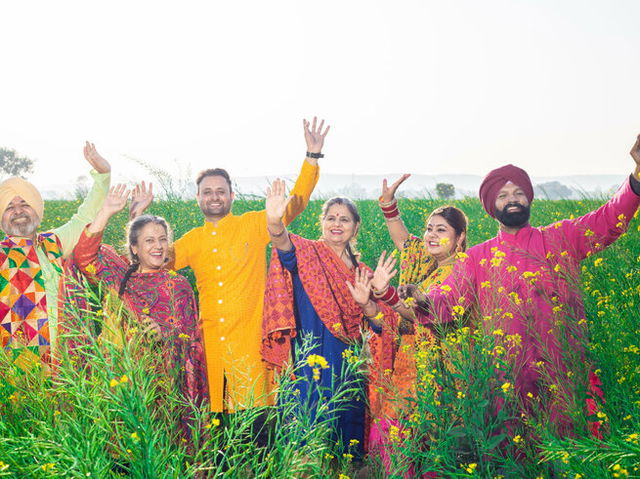Baisakhi or Vaisakhi is an important festival especially in Punjab and Northern India observed every year on April 13 or April 14.
Baisakhi is a harvest festival as its a time to celebrate the new harvest season for farmers and for Sikhs it has deep-rooted religious significance.
It is said that on April 13 in 1699 Guru Gobind Singh founded the Khalsa that shaped the Sikh identity and traditions.
Baisakhi is also connected to the history of India including the coronation of Maharaja Ranjt Singh in 1801 and the fatal Jallianwala Bagh massacre in 1919.
The festival is celebrated with prayers, processions, music, dance, and community feasts, bringing people together in a spirit of gratitude and joy.

The Month of Vaisakh And Baisakhi
Baisakhi falls on the first day of Vaisakh, the second month in the Hindu lunar calendar, which typically falls in mid-April.
Vaisakh marks the beginning of the spring season and is a period of agricultural activity in many parts of India.
This month is significant because it indicates the end of the cold winter months and the start of the warmer, more productive agricultural season.
As such, Baisakhi is seen not only as a religious and cultural celebration but also as a seasonal transition that marks a new beginning for the farming community.
The Story of Baisakhi
Baisakhi's story began with the public execution of Guru Tegh Bahadur who was the ninth Sikh Guru.
Aurangzeb, the Mughal emperor carried out his execution after he stood up for the rights of Hindus and Sikhs protesting against the forced Islam conversions.
After his death, his son, Guru Gobind Singh, became the next Sikh Guru.
Guru Gobind Singh wanted to instill courage and the spirit of sacrifice among Sikhs. On March 30, 1699, during the Baisakhi festival, he brought together thousands of Sikhs at Keshgarh Sahib near Anandpur.
He came out of his tent with a sword in his hand and gave a very powerful speech about bravery, and he proceeded to ask if anyone was willing to give their lives for their faith.
After he asked three times, a young man stepped forward. The Guru took him inside a tent and came out alone with a sword covered in blood.
He repeated this four more times, and each time, another man volunteered. The crowd feared the men had been killed.
However, Guru Gobind Singh soon brought all five men out alive.
They were now dressed in saffron-colored clothes and turbans.
These five men became the “Panj Pyare” or the “Beloved Five,” the first members of the Khalsa.
Baisakhi remains a significant day in Sikh history, celebrating courage, unity, and the spirit of selflessness that Guru Gobind Singh instilled in his followers.
The Agricultural Perspective
Baisakhi is observed mainly as a harvest festival in Punjab as it marks the end of the season of Rabi crop.
Rabi crop is significant for wheat production in the region and farmers conduct prayers and rituals to thank the Earth for its abundant harvest and to seek blessings for the prosperity of the next farming cycle.
Traditionally, farmers also hold Baisakhi fairs during this time, which serve as a platform for people to come together, celebrate the harvest, and exchange agricultural products.
It is also a time when farmers perform rituals like ‘Ardaas’ (prayer) and other customs to express their gratitude and renew their connection to the land.
The Significance Of Baisakhi
- Baisakhi marks the founding of the Khalsa by Guru Gobind Singh in 1699.
- On this day, Guru Gobind Singh initiated the Panj Pyare (Five Beloved Ones), solidifying the distinct Sikh identity.
- The festival celebrates the conclusion of the harvest season, particularly the wheat harvest in Punjab.
- Farmers express their gratitude for a bountiful crop and seek blessings for future prosperity.
- Baisakhi is marked by lively processions, traditional dances like Bhangra and Gidda, and family celebrations.
- It serves as a time for people to unite, honor their cultural heritage, and give thanks.
- The day also holds historical significance, remembering the 1919 Jallianwala Bagh massacre, a pivotal moment in India's fight for independence.
- Baisakhi stands as a reminder of the struggle for freedom and the sacrifices made for India’s independence.
Celebrations And Traditions of Baisakhi
The Sikhs celebrate it by visiting gurdwaras for prayers, reciting hymns, and engaging in community services such as langar.
The Golden Temple in Amritsar is especially vibrant during this time. For farmers, Baisakhi is a time of Thanksgiving for the bountiful harvest, particularly of rabi crops like wheat, and prayers are offered for future prosperity.
The festivities include folk dances like bhangra and gidda, along with vibrant processions where the Guru Granth Sahib is carried through the streets, accompanied by traditional music and colorful displays.
Fairs are held, featuring food, shopping, and fun activities.
Baisakhi has cultural ties, with families wearing bright traditional clothing and enjoying festive foods such as sarson da saag and makki di roti.
The festival is also recognized by Hindus, who may observe it as the day when Lord Ram was crowned in Ayodhya or as the start of the solar year in the Hindu calendar.
It's a time of joy, unity, and celebration, cherished by people of different backgrounds across India.